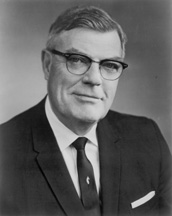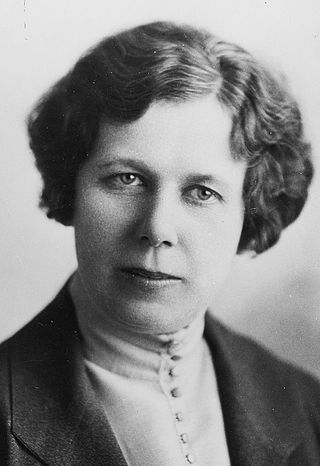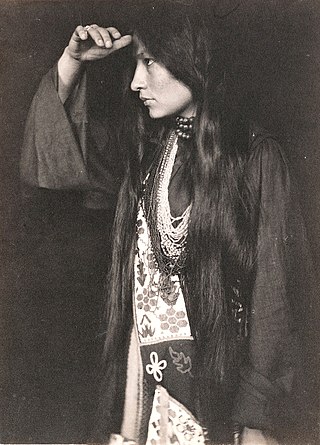
Joseph Henry Bottum was an American politician. He served as the 27th Lieutenant Governor of South Dakota and as a member of the United States Senate from South Dakota.

Gladys Shields Pyle was an American educator and national record setting female politician during the first score of years post-ratification of Women's Suffrage Amendment to the U. S. Constitution, who set numerous national and state partisan electoral records before the age of 50, including at least a dozen national records related to her 1938 U. S. Senate election. Her most significant national electoral records are:
- First female nationally to enter the U S Senate through election (1938) and first to do so in her own right at the age of 48. She ran 5.6% ahead of the second highest vote getter for any statewide office in her state in that election.
- First female nationally to run for both governor and U.S. Senate and first to do so in her own right.
- First female nationally to be elected to both a state constitutional legislative office (1922) and a state constitutional executive office (1926) in any state and first to do so in her own right. Only female nationally to be both the first elected to a state constitutional legislative office and the first to be elected to a state constitutional executive office in any state.
- First female nationally to receive more votes cast than had been received by any other statewide candidate since statehood in any state (1928).
- Second female nationally to receive both the highest percentage of the vote received of all statewide candidates and most total raw votes received of all statewide candidates in a general election in any state (1928) and first female to do so since ratification of the Suffrage Amendment in any state.

Women's suffrage was established in the United States on a full or partial basis by various towns, counties, states, and territories during the latter decades of the 19th century and early part of the 20th century. As women received the right to vote in some places, they began running for public office and gaining positions as school board members, county clerks, state legislators, judges, and, in the case of Jeannette Rankin, as a member of Congress.
This timeline of South Dakota is a list of events in the history of South Dakota by year.

Mary "Mamie" Shields Pyle was a women's suffrage leader in the U.S. state of South Dakota. She was instrumental in the state's enactment of women's suffrage in 1918.

John L. Pyle was an attorney and politician from the state of South Dakota. A Republican, he was notable for his service as State's Attorney of Hand County (1886-1888) and state Attorney General (1899-1902).

Native American women influenced early women's suffrage activists in the United States. The Iroquois nations, which had an egalitarian society, were visited by early feminists and suffragists, such as Lydia Maria Child, Matilda Joslyn Gage, Lucretia Mott, and Elizabeth Cady Stanton. These women discussed how Native American women had authority in their own cultures at various feminist conventions and also in the news. Native American women became a symbol for some suffrage activists. However, other white suffragists actively excluded Native American people from the movement. When the Nineteenth Amendment was passed in 1920, suffragist Zitkala-Sa, commented that Native Americans still had more work to do in order to vote. It was not until 1924 that many Native Americans could vote under the Indian Citizenship Act. In many states, there were additional barriers to Native American voting rights.

Women's suffrage began in North Dakota when it was still part of the Dakota Territory. During this time activists worked for women's suffrage, and in 1879, women gained the right to vote at school meetings. This was formalized in 1883 when the legislature passed a law where women would use separate ballots for their votes on school-related issues. When North Dakota was writing its state constitution, efforts were made to include equal suffrage for women, but women were only able to retain their right to vote for school issues. An abortive effort to provide equal suffrage happened in 1893, when the state legislature passed equal suffrage for women. However, the bill was "lost," never signed and eventually expunged from the record. Suffragists continued to hold conventions, raise awareness, and form organizations. The arrival of Sylvia Pankhurst in February 1912 stimulated the creation of more groups, including the statewide Votes for Women League. In 1914, there was a voter referendum on women's suffrage, but it did not pass. In 1917, limited suffrage bills for municipal and presidential suffrage were signed into law. On December 1, 1919, North Dakota became the twentieth state to ratify the Nineteenth Amendment.

Women's suffrage started in South Dakota when it was part of Dakota Territory. Prior to 1889, it had a shared history of women's suffrage with North Dakota. While South Dakota was part of the territory, women earned the right to vote on school related issues. They retained this right after it became a separate state. The state constitution specified that there would be a women's suffrage amendment referendum in 1890. Despite a large campaign that included Susan B. Anthony and a state suffrage group, the South Dakota Equal Suffrage Association (SDESA), the referendum failed. The state legislature passed additional suffrage referendums over the years, but each was voted down until 1918. South Dakota was an early ratifier of the Nineteenth Amendment, which was approved during a special midnight legislative session on December 4, 1919.

This is a timeline of women's suffrage in South Dakota. The early history of women's suffrage in the state is shared with North Dakota. When South Dakota became a state, it held a voter referendum in 1890 on an equal suffrage amendment. This effort failed, but suffragists continued to organize and lobby the legislature to pass voter referendums. None passed until 1918. South Dakota ratified the Nineteenth Amendment on December 4, 1919.











